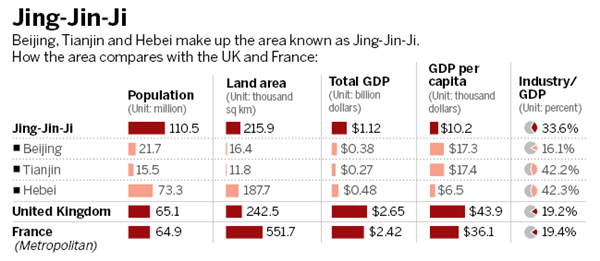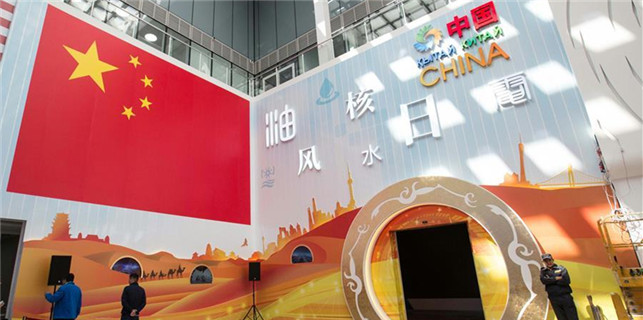New urban model

Xiongan plan will upgrade Beijing-Tianjin-Hebei region and test an economy based on knowledge, innovation
China has taken to heart Daniel Burnham's admonition: "Make no little plans, they have no magic to stir men's blood. Make big plans: aim high in hope and work, remembering that a noble, logical diagram once recorded will not die."But, the US architect who created the master plans for downtown Washington, Chicago and Manila, could not have imagined the transformational scale of China's plans for the cities of Beijing and Tianjin and the province of Hebei.
In the three years since President Xi Jinping announced an overall plan envisioning a network of cities around Beijing and a merged mega-region, more detailed infrastructure and development plans have followed.
In November, the National Development and Reform Commission announced plans to build 1,100 kilometers of new high-speed rail at a cost of 237 billion yuan ($34.4 billion) by 2030, with the goal of linking together what will be, by far, the world's largest integrated agglomeration of urban economies.
The region, which is often called Jing-Jin-Ji, will have 110 million people. Once completed, the transportation systems will allow one-hour commuting across an area larger than England, with almost twice the population.
On April 1, the central government announced the creation of the Xiongan New Area in Hebei province, about 100 kilometers southwest of Beijing. The new city will be a model for achieving the goal of the 13th Five-Year-Plan (2016-20) to transform China into an "ecological civilization". It will also be a test bed for creating a new type of economy based on knowledge and innovation, rather than on heavy industry and low wages.
Urban planning for Jing-Jin-Ji is tightly tied to many other aspects of China's plans for economic transformation. Most directly, the plans called for Tianjin to be a center of manufacturing research and for Hebei to move to higher value-added manufacturing. This will help provide jobs as China goes through industrial restructuring away from heavy industry.
Reducing polluting industry will create healthier cities. Building world-leading infrastructure ties in with President Xi's Belt and Road Initiative linking China with the rest of Eurasia and Africa.
It also gives China great export capabilities in railway equipment and infrastructure construction. The commuter rails to be constructed in Hebei will relieve congestion in Beijing, reduce the pollution caused by cars.
Finally, by making smaller cities throughout the region more attractive to live in, opportunities in their hometowns will be made available to people who now feel pressure to migrate to Beijing or Tianjin.
Agglomeration economics
Economists and urban planners see huge economic returns from providing fast communications and transportation across a region. These so-called agglomeration effects are a key part of continued economic growth. And, China still has room to grow through such urbanization.
"City clusters are key to the development of a country. The United States, the UK and Japan all have major city clusters that represent 60 percent of the country's GDP, but for China the Pearl River and Yangtze River delta regions and the Beijing-Tianjin-Hebei region contribute only 38 percent to GDP," Shao Chunfu, professor at Beijing Jiaotong University, told rail professional.com.
Robert Guild, director of transport and communications for East Asia at the Asian Development Bank, says the ADB calculates large positive returns for infrastructure investments in China.
"Agglomeration reduces the costs of interaction. It lowers costs throughout the supply chain. Plus, it allows people to generate ideas as they serendipitously come into contact with others. Economists used to think there was an upper limit on efficient city size. But, there does not seem to be an upper limit on agglomeration economies. There does not seem to be an upper limit on city size."
Recent research reinforces the importance of taking advantage of the huge productivity of cities. For example, a 2015 paper by economists Chang-Tai Hsieh and Enrico Moretti showed that 90 percent of US growth comes from cities. Since the 1970s, most of the growth came from a small number of cities in the South and Midwest, which allowed housing to be built and encouraged development.
Strikingly, they conclude that restrictions on building new housing in highly productive cities such as New York, San Francisco or Silicon Valley reduced total US GDP by almost 10 percent by preventing people from moving to them. Instead, the potential growth of those areas just went into unproductive increases in housing prices.
Huang Wenzheng, senior fellow at the Center for China and Globalization, emphasizes that point: "Labor mobility is the key to economic vibrancy because it can, in principle, better allocate human capital."
Investing in the infrastructure to create extended urban agglomerations is the next logical step in China's long-term plans. Barjor Mehta, lead urban specialist for East Asia and the Pacific at the World Bank, says: "China has built a remarkable network of high-speed rail connecting all the cities. It has also been doing metros in each big city. The next thing when you want to encourage development of a metropolitan region is to seamlessly connect the smaller cities within the region with the metropolitan core. Each of the smaller cities themselves has its own internal transportation. The next big benefit you get is having much better connections within the extended metropolitan regions, linking a very large city with other cities within commuting distance around it."
The Beijing government announced plans in April to double the amount of land allocated for residential development this year to 12 million square meters, enough to meet the city's housing demand for this year, as reported by the Caixin magazine. But, the planned investments in Jing-Jin-Ji can be seen as a way to spread the productivity of Beijing and Tianjin through out Hebei.
















